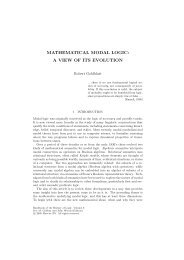Zermelo-Fraenkel Set Theory
Zermelo-Fraenkel Set Theory
Zermelo-Fraenkel Set Theory
You also want an ePaper? Increase the reach of your titles
YUMPU automatically turns print PDFs into web optimized ePapers that Google loves.
CHAPTER 4. ORDINALS 37<br />
Theorem 4.32 (Cantor Normal Form) Fix θ > 1. Every ordinal α can be written in<br />
exactly one way as α = θ β1 · γ 1 + · · · + θ β k<br />
· γ k with β 1 > · · · > β k and γ 1 , . . . , γ k < θ.<br />
The Cantor Normal Form Theorem for θ = 10 justifies our use of decimal notations<br />
for natural numbers. For θ = ω it offers “notations” (in terms of natural numbers) for<br />
all ordinals below ε 0 := ⋂ {α | ω α = α} = ⋃ {ω, ω ω , ω ωω , . . .}. This is used in Gentzen’s<br />
consistency proof for Peano arithmetic.<br />
Definition 4.33 α is called critical for the operation F : OR 2 → OR if β, γ < α ⇒<br />
F (β, γ) < α.<br />
□<br />
Exercises<br />
94 ♣ Show: α · ω is the least ordinal > α that is critical for +.<br />
95 ♣ For α ω, the following are equivalent:<br />
1. α is critical for +; 2. β < α ⇒ β + α = α; 3. ∃ξ (α = ω ξ ).<br />
96 ♣ Assume α ω.<br />
Show: α ω is the least ordinal > α that is critical for multiplication.<br />
97 ♣ Show that, for α ω, the following are equivalent:<br />
1. α is critical for multiplication; 2. β < α ⇒ β · α = α; 3. ∃ξ (α = ω ωξ ).<br />
98 ♣ Show: every initial is critical for addition, multiplication and exponentiation.<br />
4.8 Well-ordering of OR × OR<br />
Definition 4.34 Define the relation < on OR × OR by:<br />
(α, β) < (α ′ , β ′ ) :≡<br />
max(α, β) < max(α ′ , β ′ ), or: max(α, β) = max(α ′ , β ′ ) ∧ [α < α ′ ∨ (α = α ′ ∧ β < β ′ )].<br />
□<br />
99 ♣ Exercise Show:<br />
1. < well-orders OR × OR,<br />
2. every product γ × γ is an initial segment<br />
(if (α, β) < (α ′ , β ′ ) ∈ γ × γ, then (α, β) ∈ γ × γ),<br />
3. the product ω × ω is well-ordered in type ω,<br />
4. every product ω α × ω α (α > 0) is well-ordered in type ω α .<br />
Hint. 4 says that, if Γ : OR × OR → OR is the unique order-preserving map, then<br />
Γ(ω α , ω α ) = ω α . Use induction w.r.t. α. If equality doesn’t hold, then we must have<br />
Γ(ω α , ω α ) > ω α . Then (β, γ) ∈ ω α × ω α exists such that Γ(β, γ) = ω α , etc.<br />
Part 4 of this exercise has the important<br />
Corollary 4.35 ω α × ω α = 1 ω α .<br />
□

















